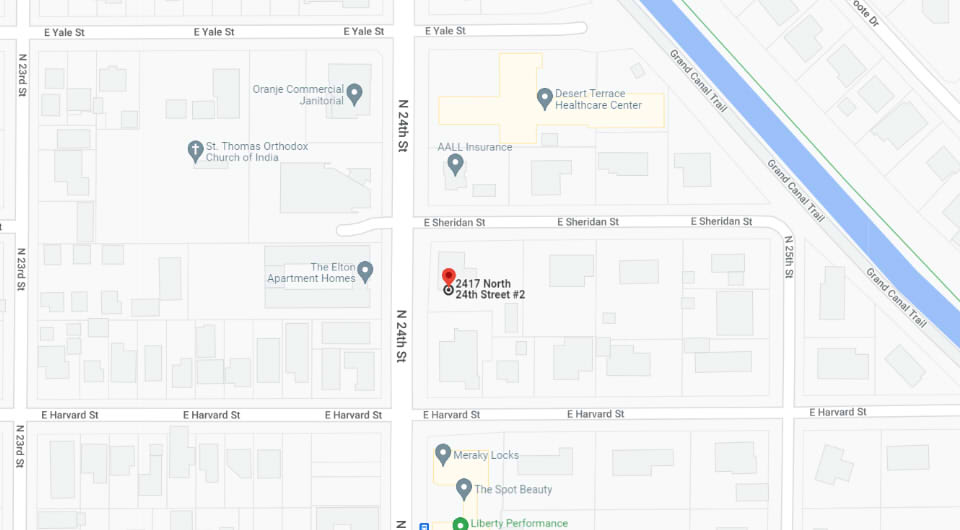Birth injuries result in emotionally turbulent and tragic experiences for new parents, particularly if the injuries could have been prevented. In some cases, like those that involve birth asphyxia, the damage can be irreversible and have life-changing repercussions for the newborn and their families. In the worst-case scenario, the infant could die.
Birth asphyxia often occurs due to the negligence of the team that attends to women through their pregnancy and during delivery, including obstetricians, nurses, or attending physicians. If your baby suffered birth asphyxia that resulted in death or the development of severe injuries, you may be eligible to file a medical malpractice claim against the negligent party. With help from a birth asphyxia injury attorney, you may be capable of successfully pursuing damages for the injuries or death your baby has suffered.
At the Phoenix Personal Injury Attorney Law Firm, we boast birth injury attorneys who are nationally recognized trial lawyers and medical doctors. In complex cases such as those related to birth asphyxia, this degree of medical and legal experience is valuable to parents who rely on us to fight for fair compensation and justice. Call us today to share the details of your case, and we will devise a proper strategy to help you.
Defining Birth Asphyxia
Birth asphyxia is also known as neonatal asphyxia or perinatal asphyxia. It occurs when babies are deprived of oxygen during delivery, labor, or shortly after birth, which could, in turn, result in the baby suffering a physical injury. Whereas oxygen deprivation and lack of or reduced blood flow after or during delivery can result in most of a baby's organs (like the heart, lungs, kidneys, and liver) being damaged, it is most worrying in terms of the high possibility of causing permanent brain damage.
Many events occur near or during delivery that could cause an infant to experience asphyxia. But the medical team can quickly deliver the infant before oxygen deprivation leads to permanent injury if it closely observes the baby and mother during delivery and labor and correctly interprets the infant's heart tracings on the fetal heart monitor.
Often, delivery through a cesarean section is the safest and fastest method to deliver an infant in distress. When an infant has suffered oxygen deprivation, known as fetal distress, it manifests on the fetal heart monitor as a non-reassuring tracing.
Causes of Birth Asphyxia
The following are incidents that can lead to a baby suffering birth asphyxia:
- Brain bleeds (intracranial hemorrhages): A brain bleed can result from a traumatic delivery. Vacuum extractors and forceps can cause HIE and brain bleeds. CPD (cephalopelvic disproportion) management, shoulder dystocia, and abnormal presentations (breech or face presentation) also place a baby at an increased risk of experiencing HIE and an intracranial hemorrhage.
- Fetal stroke: When the blood vessels in the infant's brain become restricted or blocked. Vacuum extractors and forceps can cause the baby to have a stroke, causing severe oxygen deprivation. Stroke and HIE often occur together.
- Arrested and prolonged labor: Labor contractions are traumatic for the infant. Consequently, when a mother experiences prolonged labor, the baby's brain can lack oxygen, and the deprivation worsens, mainly if Cytotec and Pitocin are used.
- Anesthesia errors: These mistakes can lead to the mother developing blood pressure issues, including a hypotensive crisis.
- Oligohydramnios: This is a condition where the mother's amniotic fluid level is low. Oligohydramnios increases the infant's risk of having a compressed or prolapsed umbilical cord. It can also cause meconium aspiration syndrome, which can cause oxygenation problems and respiratory distress.
- PROM (premature rupture of the membranes) and premature birth: PROM happens when the mother's water breaks before she goes into labor. Premature rupture of the membranes can lead to premature birth, umbilical cord compression, and the baby being born before their lungs are fully developed, causing their brain to be deprived of oxygen.
- Eclampsia/preeclampsia: A condition where the mother is diagnosed with high blood pressure during pregnancy. Preeclampsia or eclampsia can lead to decreased blood flow to the infant.
- Ruptured womb (uterus): This is when all the womb layers develop a tear. A ruptured womb can lead to the mother severely hemorrhaging, and the infant may even flow into the mother's abdomen. The hemorrhaging may make the mother lose a lot of blood, resulting in decreased blood flow to the infant. Or, the tear might be in an area that impacts blood circulation between the placenta and uterus.
- Hyperstimulation caused by Cytotec and Pitocin can lead to oxygen deprivation that progressively worsens.
- Placenta previa: This happens when the placenta grows close to the opening of the uterus, entirely or partially blocking the mother's cervix (the opening to the birth canal).
- Improper monitoring of the fetus: as the standard of care, healthcare providers are mandated to monitor the infant's heart rate immediately after the mother is admitted to the labor room. Failure to promptly recognize and act on non-reassuring heart tracings can lead to the baby experiencing severe asphyxia.
- Delayed emergency cesarean section: Birth complications often warrant quickly delivering the baby. A delay could mean the infant is deprived of oxygen for too long.
- Cord issues: umbilical cord problems that cause neonatal asphyxia include the cord wrapped around the baby's neck (nuchal cords), the umbilical cord being in a true knot, a short cord, and cord prolapse. These conditions may lead to an infant wholly or partially lacking oxygen.
- Placental abruption: This is an incident where the placenta (the sac holding the infant) detaches from the uterine wall. This can lead to the baby lacking oxygen and severe bleeding.
- Improperly managing the child's respiration after their birth: this entails failing to manage an infant on a breathing machine appropriately (this can lead to overventilation injuries, like a hole in the lungs and hypocarbia), failing to manage apnea (times of breathing cessation) appropriately, and failing to administer correct amounts of surfactant, a drug that assists with lung compliance and lung maturity in premature lungs.
Birth Asphyxia-Related Injuries
Because of the increased risk of severe, long-lasting injury, birth asphyxia necessitates the urgent attention of health care providers with a proper response. This is because the seriousness of the injuries babies sustain from perinatal asphyxia depends significantly on the following factors:
- The severity of oxygen deprivation.
- The amount of time the baby has suffered oxygen deprivation.
- How quickly the doctors administer proper treatment.
A baby may fully recover in less moderate cases, although most incidences cause death or permanent injury. In the earlier stages of asphyxia, a baby can develop hypoxia. Hypoxia is a medical condition characterized by inadequate oxygen levels in tissues and the blood.
This condition can eventually lead to acidic blood (acidosis), which can cause low blood pressure, reduced heart function, ischemia (reduced blood flow to the brain), and irreversible brain damage.
Prevalent birth injuries related to birth asphyxia include:
- Visual, hearing, and feeding impairments.
- Motor disorders.
- Learning and developmental disabilities.
- Cerebral palsy and other spasticity problems.
- Fetal stroke.
- Pulmonary edema.
- Neonatal seizures.
- HIE (hypoxic ischemic encephalopathy).
- Catatonia.
- Heart failure.
- Acute kidney injury.
- Lowered IQ.
- Mild or moderate disability.
- Epilepsy.
If the birth asphyxia is prolonged, severe, and improperly treated, the risk of it causing impairment and life-changing injuries increases dramatically. This could include long-term emotional, mental, and physical disabilities and an increased need for medical attention or 24/7 attendant care throughout a baby's lifetime, all of which can be financially and emotionally demanding for families.
Common Warning Signs of Birth Asphyxia
Medical professionals in the labor and delivery room should watch out for these prevalent warning symptoms of perinatal asphyxia before birth:
- An increased level of acid in the infant's blood.
- Abnormal fetal heart rhythm or rate.
At birth, signs of perinatal asphyxia may include:
- Difficulty breathing due to meconium in the amniotic fluid, which blocks airways. Meconium is the first bowel movement a baby passes.
- Weak or gasping breathing.
- Weak cry.
- Weak muscle reflexes and tone.
- Low heart rate.
- Pale or bluish color.
Liability for Birth Asphyxia Injuries
Establishing whether birth asphyxia occurred due to medical negligence is among the most critical initial steps in birth injury cases. Through thorough investigations, your attorney can carefully assess the facts surrounding the attending healthcare professionals' actions before, during, and after delivery to establish whether they were negligent in their discharge of services.
Attending medical professionals, such as an obstetrician, nurse, midwife, or attending physician, can be negligent in the following ways:
- Improperly using labor-inducing medications like Pitocin or equipment like forceps and vacuum extractors, especially in prolonged or complicated deliveries.
- Failure to appropriately treat perinatal asphyxia and resulting injuries, including failing to perform brain cooling (hypothermia therapy), which should be done within a few hours after asphyxia to prevent more lasting or severe injuries by protecting brain cells.
- Failing to monitor the baby's vitals during delivery and labor to identify fetal distress signs and respond appropriately.
- Failure or delay to conduct a cesarean section when justified by a complicated or prolonged birth or other specific circumstances.
- Failing to diagnose and deal with known causes of birth asphyxia correctly.
The hospital where your baby's birth asphyxia-related injury occurred can also be to blame, mainly when a staff member's negligence resulted in your infant's permanent injury. Another possible liable party for your baby's injury is an alternate healthcare provider (separate from the medical team overseeing your delivery and labor) who neglected to intervene when you began showing pregnancy complication signs. A respiratory therapist, nurse, or doctor who failed to administer appropriate care to the child after delivery can also be liable.
Proving Negligence in Birth Asphyxia Cases
To prevail in your birth asphyxia lawsuit or claim, you must prove the team of medical professionals that attended to you was negligent. Under Arizona personal injury law, negligence comprises four elements. Therefore, you must demonstrate these four elements to show that a party was negligent in discharging their duties, leading to a birth asphyxia injury. These elements are:
- The at-fault party owed you and your baby a duty of care, which requires them to administer treatment with the skill and immediacy necessitated by medical professional standards.
- They breached that duty by acting negligently (outside the standards of medical care), placing your child in danger of injury. For example, they delayed a C-section.
- Their breach of duty caused your baby to suffer asphyxia, which led to an injury.
- You incurred various damages from your baby's asphyxia-related injury, like medical bills.
You should have evidence to prove your baby's specific injury and the damages resulting from those injuries. An example of the evidence you need is the medical records.
You do not have to collect all the evidence yourself. Once you retain a birth asphyxia lawyer, they will investigate the case to see whether there is adequate evidence to file a claim. They may review your baby's hospital records and medical reports from your baby's doctor and consult medical experts concerning potential negligence.
If they have adequate evidence to build a case, your lawyer will help you determine and pursue the damages you suffered. While this occurs, you can concentrate on caring for your child rather than engaging in the legal battle you face.
Recoverable Damages in Birth Asphyxia Injury Cases
Any repercussions of your baby's injury due to birth asphyxia may qualify for compensation. The following are some of the economic and non-economic damages you could pursue and recover in your birth injury claim or lawsuit:
- Medical bills resulting from treating the injury your child suffered due to birth asphyxia.
- All medical expenses for ongoing treatment and care your baby will require because of their birthday asphyxia injury.
- Transportation, assistive devices, medication, and other out-of-pocket medical expenses.
- Specialist care.
- Lost income for the parent who had to stop working to take care of the injured baby.
- Emotional distress.
- Pain and suffering.
- Mental anguish.
- Disabilty.
- Disfigurement.
- Loss of enjoyment of life.
- Other economic and non-economic damages.
You may be entitled to wrongful death damages if your baby died due to birth asphyxia caused by medical negligence. Wrongful death damages include funeral and burial costs, medical bills for the period the baby was undergoing treatment before it died, and emotional distress.
Some states cap damages. That means they limit the amount of compensation a person can recover from an injury claim. Fortunately, Arizona State does not place a cap on damages. The Arizona Constitution prohibits caps on damages for civil lawsuits and claims. That means there is no damage cap on your compensation.
That is good news for you and your baby because you might require substantial compensation to cover your baby's medical care. An experienced lawyer can do everything legally possible to maximize the compensation you recover for your lawsuit or claim.
Statutes of Limitations in Birth Asphyxia Cases
You must bring your birth injury claim within the state's statute of limitations to increase your chances of success. Under Arizona Revised Statutes 12-542, the time frame for filing a birth injury claim is two years from the date of the injury. However, if the victim is under 18, Arizona Revised Statutes 12-502 allows for an extension of the deadline. Therefore, parents who realize several years later that their baby suffered perinatal asphyxia injuries may still sue for damages.
How an Attorney Can Help Your Case
When you retain a perinatal asphyxia attorney, they can handle all aspects of your case by providing you with these services:
- Gathering evidence to assess your damages: Your lawyer can assist you in determining what kinds of damages you might be entitled to and the amount of money these damages are worth. That includes calculating the value of future general and special damages.
- Obtaining expert testimony: Considering how technical medical negligence cases are, Arizona permits plaintiffs in birth asphyxia cases to provide testimony from an experienced medical expert, according to Arizona Revised Statutes 12-2602. An attorney can take care of approaching medical experts to testify on your behalf.
- Providing legal counsel and representation: An attorney will be your legal representative. They will communicate with all parties in your case on your behalf. That means you will not have to deal with insurance companies or be pressured to accept a settlement offer that is not fair.
- Filing your claim and pursuing fair compensation: Once they have built your birth asphyxia case, your lawyer will help you file an insurance lawsuit or claim. If the insurer disagrees with your lawyers' demands, the lawyers will start negotiations. And if the insurer does not make a fair settlement offer, your lawyer will help you file a lawsuit and fight for you at trial.
Find a Phoenix Personal Injury Attorney Near Me
If medical negligence led to your baby experiencing birth asphyxia and, in turn, suffering an injury, you deserve compensation from the at-fault party. Contact an attorney experienced in birth asphyxia cases to assist you in understanding your financial and legal options.
At the Phoenix Personal Injury Attorney Law Firm, we are passionate about protecting the legal rights of parents whose children have suffered birth asphyxia-related injuries due to medical negligence. Having handled thousands of cases, and thanks to our medical insight and experience, we have the necessary resources and tools to guide parents through challenging personal and legal situations and fight for the compensation they deserve.
We will thoroughly review your case and collect the necessary evidence before devising a strategy that will yield the best possible outcome for your case. Call us at 602-641-9589 to share the details of your case.










